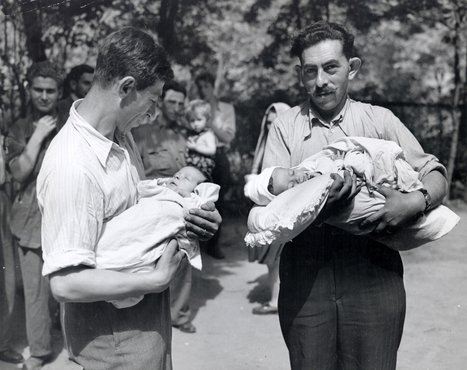Starting Over
Eastern European Jews fled eastward to escape the Nazis. On return to their countries of origin, they were often met by anti-Semitism and violent encounters. Desperate, they then headed to the relative safety of camps in the U.S.-Occupied Zones. This flood of refugees taxed the already chaotic camps. But it also introduced a more intact communal life into the camps which benefited all. The growing population of babies born there brought a new element of joy.
the first flood – a place to go
Those fleeing Eastern Europe, including large numbers of families and orphaned children, overwhelmed the U.S. Zones in Austria. By December 1946, roughly 13,200 Jews occupied eight camps in the Salzburg area alone. As existing facilities became impossibly overcrowded, transient camps were opened to house the new arrivals until better accommodations were available.


Let Them In
Worried about diminishing resources, the U.S. Army and UNRRA initially attempted to block entry to these “infiltrees,” since they had not been among the survivors initially arriving in the camps. JDC lobbied on behalf of the newcomers, who were eventually admitted. This required increasing staff and supplies to look after them.



On their own but not alone
Children also began arriving on their own from Eastern Europe, some in chaperoned groups, some unaccompanied, and sought refuge in the U.S. Zones.



reconnecting – where are you?
Survivors were desperate to learn the fate of loved ones. Many traveled from camp to camp to that end. Jews elsewhere also searched for relatives and friends whose fates were unknown. JDC’s Tracing Bureau, in liaison with the U.S. Army, pursued hundreds of thousands of inquiries.


The Second Flood – a new generation arrives
As survivors began to rebuild their lives, the opportunity and desire to bring children into the world returned. The urge to start new families resulted in a baby boom. As of December 1947, almost one third of women of child-bearing age within the camps had new infants or were expecting.



New lives, new solutions
At first, children were being wrapped in newspapers at birth. The desperate call for layettes and other infant-related items was answered by JDC’s Supplies for Overseas Survivors drive conducted with the participation of national Jewish organizations. By 1949, SOS had contributed 12,000,000 pounds of clothing, supplies and medicine, and 14,000,000 pounds of food.


Handle with care
In the shifting, often inhospitable environment of the DP camps babies were particularly vulnerable. JDC provided pre- and post-natal medical care, extra rations for expectant and nursing mothers, nutritious foods for young children, and the supplies needed to ease their entry into the world.




